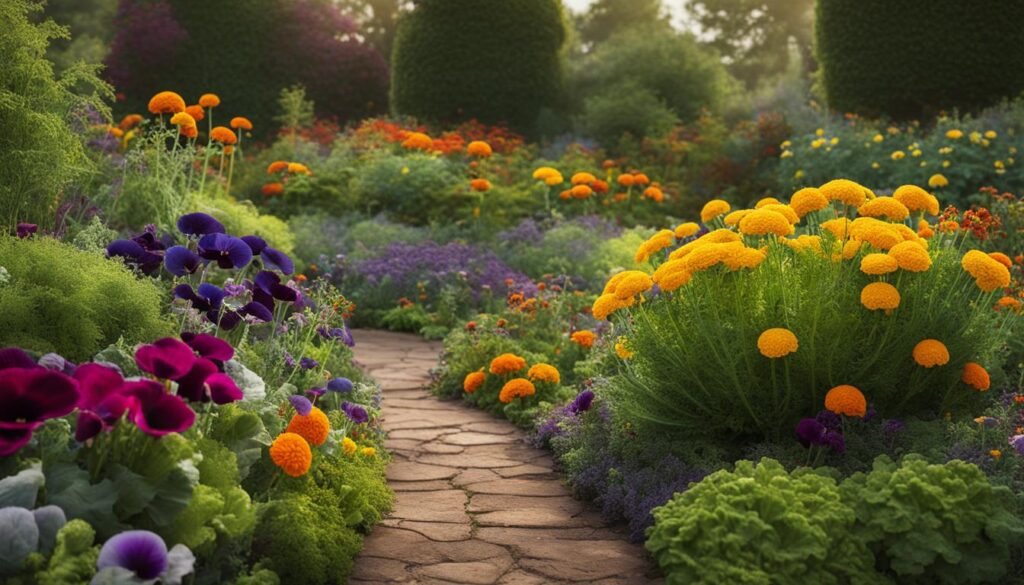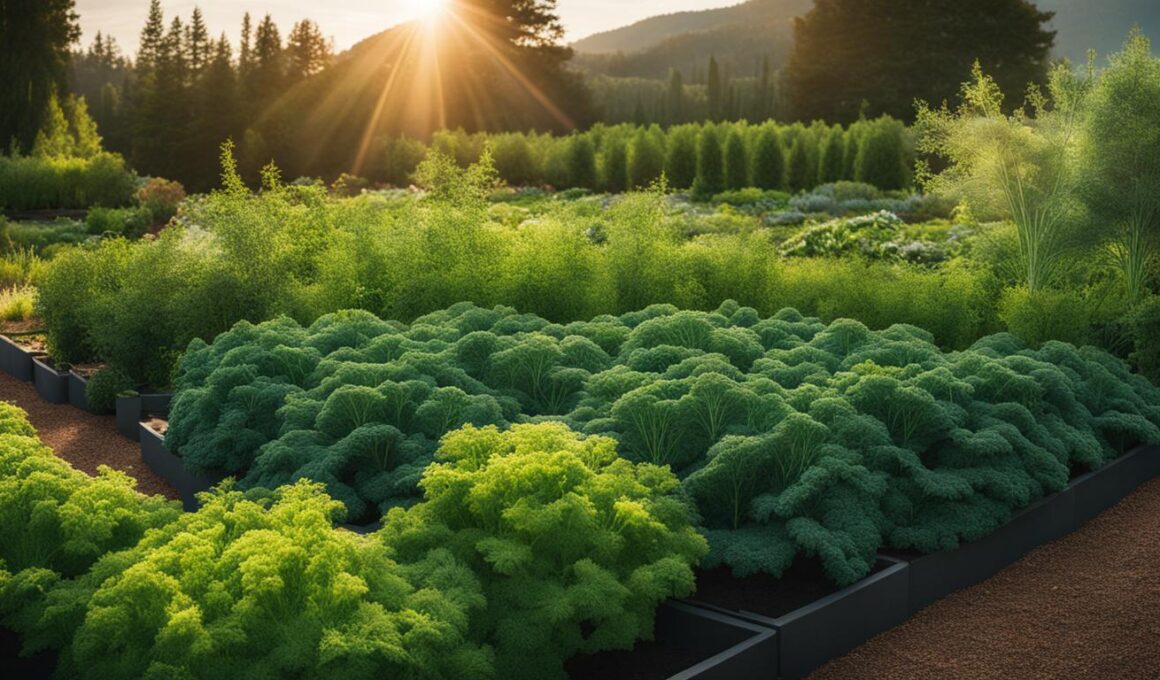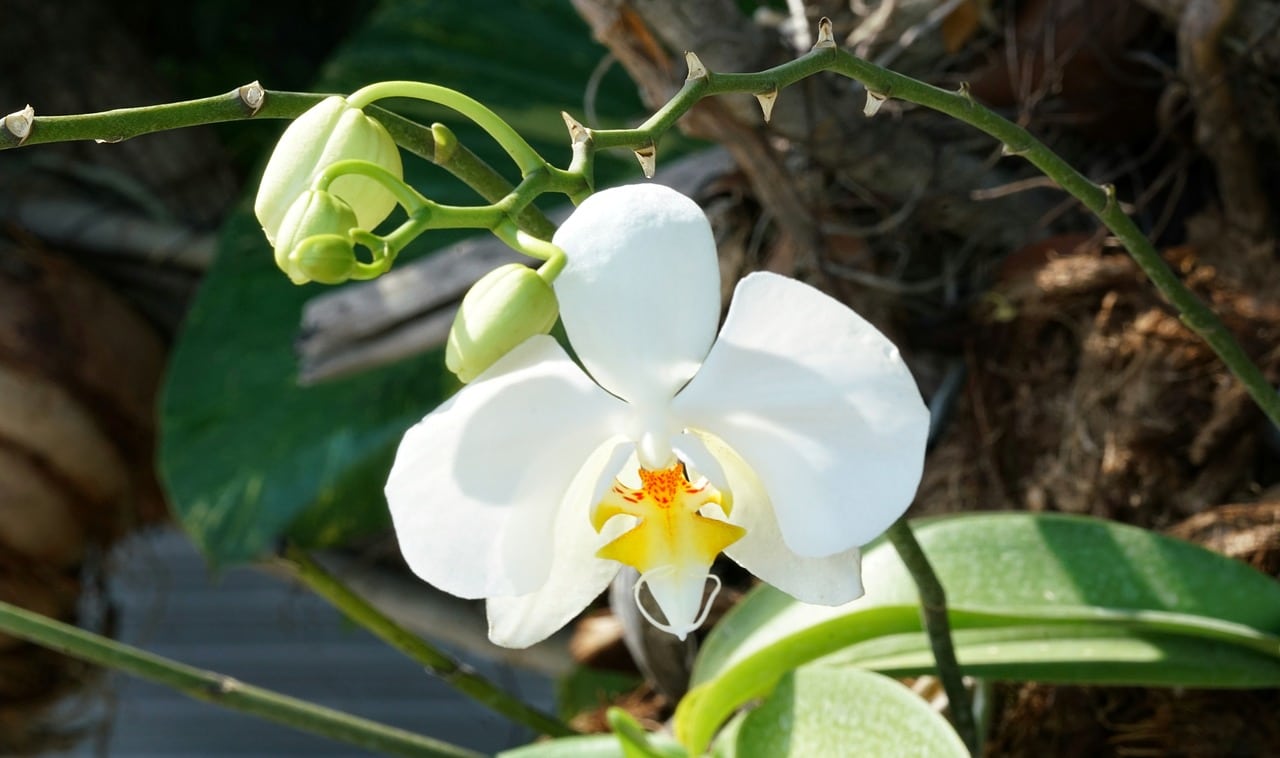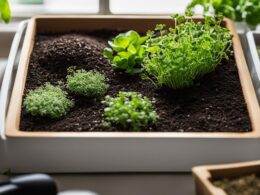Growing kale and dill together can offer many benefits. Kale is a nutrient-dense, versatile vegetable, while dill adds flavor and attracts beneficial insects. Companion planting is a method that maximizes the resilience of your garden by creating symbiotic relationships between different plant species. By growing kale and dill together, you can protect your kale from pests, improve nutrient absorption, and reduce the need for pesticides or organic sprays. Let’s explore the details and functions of companion plants for kale.
Post Summary:- Growing kale and dill together through companion planting offers numerous benefits.
- Companion planting can protect kale from pests and improve nutrient absorption.
- Select companion plants that repel pests or attract beneficial insects.
- Consider the growing requirements of both kale and companion plants.
- Plant companions at the proper time and spacing for optimal growth.
The Best Companion Plants for Kale
Companion plants play a crucial role in the growth and protection of kale. By strategically choosing plants that repel pests and attract beneficial insects, you can create a thriving ecosystem in your garden. Here are some of the best companion plants for kale:
- Sweet alyssum: This fragrant flower attracts beneficial predatory insects and pollinators, helping to control pests and promote pollination in your kale patch.
- African marigolds: These vibrant flowers not only add beauty to your garden but also act as natural pest repellents both aboveground and in the soil.
- Calendula: Known for its bright, orange flowers, calendula attracts beneficial insects that prey on garden pests, enhancing the overall health of your kale plants.
- Cilantro: The leaves of cilantro have natural pest-repelling properties, making it a great companion plant for kale.
- Dill: Dill flowers are loved by beneficial predatory insects, such as lacewings and ladybugs, which help control aphid populations that can damage kale leaves.
- Allium family: Plants like garlic, chives, leeks, and onions from the allium family can keep pests away from kale due to their strong-smelling compounds.
By incorporating these companion plants into your kale patch, you can reduce pest pressure, prevent diseases, and improve the overall health of your kale plants. The combination of these plants creates a diverse and balanced ecosystem, promoting a bountiful kale harvest.
Companion Plants for Kale
| Companion Plant | Benefits |
|---|---|
| Sweet Alyssum | Attracts beneficial predatory insects and pollinators |
| African Marigolds | Repels pests both aboveground and in the soil |
| Calendula | Attracts beneficial insects that control garden pests |
| Cilantro | Repels pests |
| Dill | Attracts beneficial predatory insects that control aphids |
| Allium Family (garlic, chives, leeks, onions) | Repels pests with their strong-smelling compounds |
These companion plants for kale not only offer protection but also add beauty to your garden. Consider incorporating them into your kale patch to create a thriving and resilient ecosystem that will benefit both your kale and other plants nearby.
Herbs and Flowers as Kale Companions
When it comes to companion planting for kale, herbs and flowers can add both beauty and functionality to your garden. Certain herbs and flowers have natural properties that make them excellent companions for kale, helping to deter pests, attract beneficial insects, and improve overall plant health.
One herb that thrives alongside kale is rosemary. Its strong fragrance acts as a natural repellent for garden pests, keeping them away from your kale plants. Additionally, rosemary is a hardy herb that requires similar growing conditions to kale, making it a compatible companion in terms of sunlight and soil requirements.
Flowers can also play a vital role in companion planting for kale. Nasturtiums, with their vibrant blooms, add beauty to your garden while also acting as a natural pest deterrent. These colorful flowers release compounds that repel aphids, whiteflies, and squash bugs, protecting your kale from damage.
| Herbs | Benefits |
|---|---|
| Rosemary | Repels garden pests with its fragrance |
| Hyssop | Attracts beneficial insects |
| Cilantro | Repels pests and attracts hoverflies |
In addition to rosemary and nasturtiums, other herbs and flowers that make excellent companions for kale include hyssop and cilantro. Hyssop is known for attracting beneficial insects such as bees and butterflies, which can aid in pollination and improve overall plant health. Cilantro, on the other hand, not only repels pests but also attracts hoverflies, which feed on aphids and other harmful insects.
By incorporating these herbs and flowers into your kale garden, you can create a diverse and harmonious ecosystem that promotes the health and productivity of your plants. Experiment with different combinations of herbs and flowers to find the companions that work best for your kale and enjoy the added benefits they bring.

Growing Conditions and Tips for Companion Planting Kale
When it comes to growing kale and companion plants together, it’s important to consider the specific growing conditions that will promote healthy growth for both. Kale is a cool-season crop that thrives in full sun or partial shade. It prefers loamy, well-draining soil with a pH level ranging from 5.5 to 6.8. The key is to ensure the growing conditions are compatible for both kale and its companion plants.
Some companion plants, such as dill and cilantro, also thrive in cool weather and have similar growing needs to kale. This makes them ideal choices for planting together. When establishing your garden, be sure to plant companions at the proper time and spacing to allow both plants to thrive. Consider intercropping by planting companion plants at the perimeter or between rows of kale to maximize their benefits.
Tips for Successful Companion Planting with Kale:
- Provide consistent watering: Kale and its companion plants require regular watering to maintain healthy growth. Keep the soil evenly moist, especially during dry periods.
- Mulch the soil: Mulching around the plants helps retain moisture, suppresses weed growth, and regulates soil temperature.
- Monitor for pests: While companion plants can help deter pests, it’s essential to keep an eye out for any signs of infestation. Early detection and proactive pest management are key.
- Rotate crops: To prevent the buildup of pests and diseases, practice crop rotation by planting kale and its companion plants in different areas of your garden each year.
- Harvest regularly: Harvesting kale and its companion plants regularly promotes continuous growth and prevents overcrowding.
By following these tips and providing the right growing conditions, you can create a thriving garden where kale and its companion plants coexist harmoniously. Remember that companion planting is a continuous learning process, so don’t be afraid to experiment and discover what works best for your specific garden environment.

Can Kale and Lettuce Be Grown Together in the Same Garden?
Growing kale and lettuce together in the same garden can be a great idea. Both belong to the same family of plants, and their requirements for sun, water, and nutrients are quite similar. By planting them side by side, you can maximize your garden space and enjoy a diverse harvest of fresh greens. Furthermore, kale’s tall structure can provide shade and protection for the more delicate lettuce leaves during hot summer days.
Conclusion
Growing kale and dill together through companion planting offers numerous benefits. By attracting beneficial insects, repelling pests, and improving overall plant health, companion plants can help you grow a successful and bountiful kale harvest.
Experiment with different combinations of companion plants and enjoy the beauty and benefits they bring to your garden. Unlock the secrets of your garden by harnessing the power of companion planting and watch your kale and dill thrive together.
Can Kale and Dill Be Grown Together in the Same Garden?
Yes, kale and dill can be grown together in the same garden. These two plants have different growth habits and can complement each other. While kale prefers cooler temperatures, dill enjoys full sun. This makes them compatible companions in the garden, much like growing cauliflower and beans together.
FAQ
Can I grow kale and dill together?
Yes, growing kale and dill together can offer many benefits. Dill adds flavor and attracts beneficial insects, while kale provides nutrients and versatility. Companion planting kale and dill can help protect your kale from pests, improve nutrient absorption, and reduce the need for pesticides.
What are the best companion plants for kale?
Some great companion plants for kale include sweet alyssum, African marigolds, calendula, cilantro, dill, garlic, chives, leeks, onions, hyssop, marigolds, nasturtiums, catnip, and rosemary. These plants can help reduce pest pressure, prevent diseases, and improve the overall health of your kale plants.
Can herbs and flowers be companion plants for kale?
Absolutely! Herbs and flowers like hyssop, marigolds, nasturtiums, catnip, cilantro, rosemary, and sweet alyssum can make great companion plants for kale. They not only add beauty to your garden but also attract beneficial insects and repel garden pests.
What are the growing conditions for kale and companion plants?
Kale is a cool-season crop that thrives in full sun or partial shade. It prefers loamy, well-draining soil with a pH of 5.5-6.8. When growing kale and companion plants together, it’s important to consider their similar growing requirements. Proper planting time and spacing are crucial for both plants to thrive.
Why should I grow kale and dill together through companion planting?
Growing kale and dill together through companion planting offers numerous benefits. By attracting beneficial insects, repelling pests, and improving overall plant health, companion plants can help you grow a successful and bountiful kale harvest. Experiment with different combinations of companion plants and enjoy the beauty and benefits they bring to your garden.









